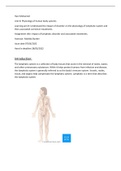Hani Mohamed
Unit 8: Physiology of human body systems
Learning aim B: Understand the impact of disorder on the physiology of lymphatic system and
then associated corrective treatments.
Assignment title: Impact of lymphatic disorder and associated treatments.
Assessor: Matilda Bunker
Issue date 07/03/2022
Hand in deadline 28/03/2022
Introduction:
The lymphatic system is a collection of body tissues that assist in the removal of toxins, waste,
and other unnecessary substances. While it helps protect humans from infection and disease,
the lymphatic system is generally referred to as the body's immune system. Vessels, nodes,
tissue, and organs help compensate the lymphatic system. Lymphatic is a term that describes
the lymphatic system.
,
, Structure of the lymphatic system:
The lymphatic system consists of:
❑ Vessels that transport lymph fluid.
❑ Lymph nodes lymphatic tissue surrounded by a capsule.
❑ Lymph nodules lymphatic tissue not surrounded by a capsule.
❑ Lymphatic tissue in the mucous membranes, walls of the GI tract, airways, urinary and
reproductive tracts and in small amounts, all organs.
❑ Lymphatic organs –lymph nodes, spleen, thymus.
Mucous membranes: The mucous membrane consists of a layer of epithelial cells under
structural tissue that lines the body parts that are open to the outside; cells in the mucous
membrane secrete mucus to avoid the membrane from drying out.
The lymphatic system – lymph nodules:
Lymph nodules which are lymphatic tissue not surrounded by a capsule
Characteristics:
❑ Its shape is oval.
❑ Greater lymphocytes are located at the center of the lymphatic tissue, whereas smaller
lymphocytes are located in the periphery.
❑ Tonsils, Payer's patches in the ileum wall, and the appendix wall are among some of the
locations where this can be found.




